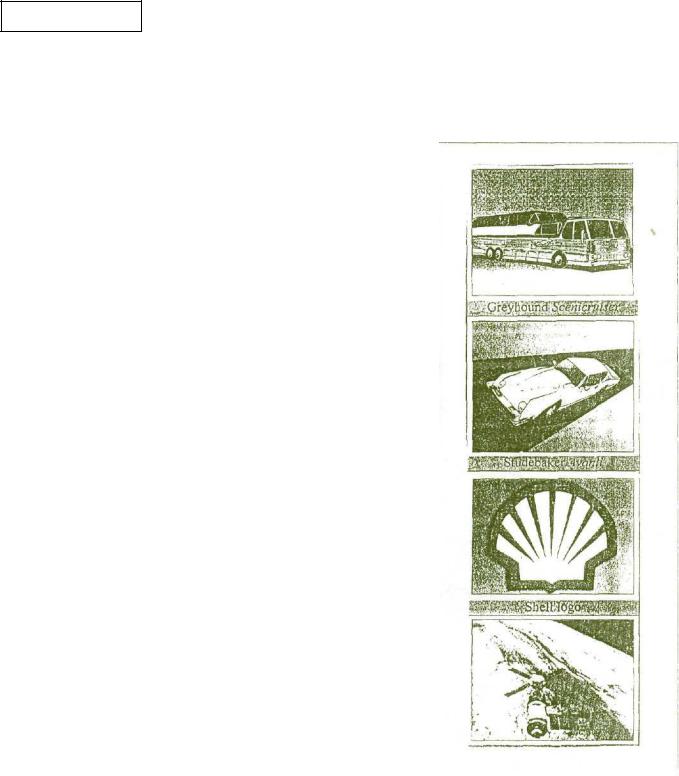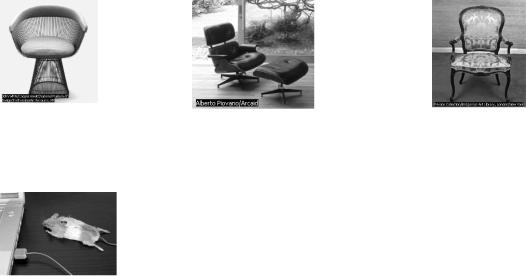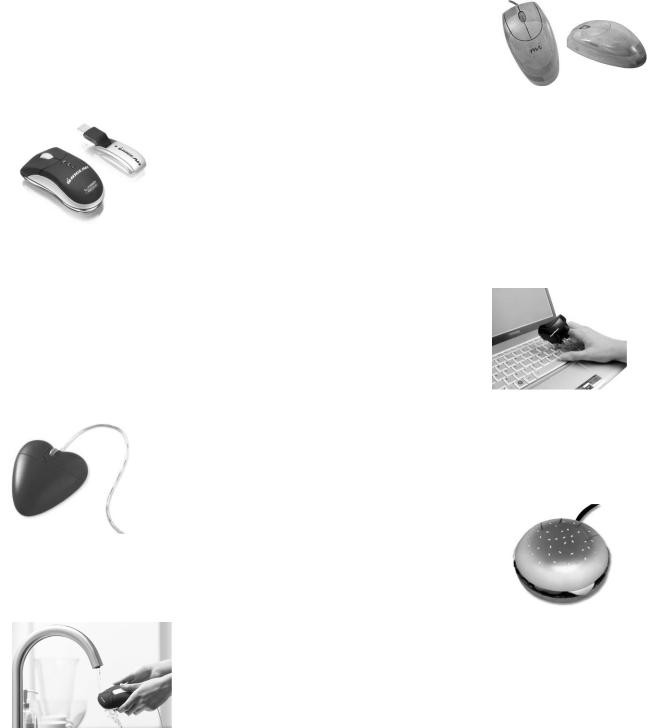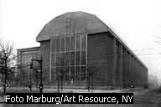
Учебные задания по английскому языку для студентов 2 курса специальности «Промышленный дизайн», 3 семестр (90
..pdf
2053
Министерство образования и науки РФ Федеральное государственное бюджетное образовательное учреждение
высшего профессионального образования «Липецкий государственный технический университет»
КАФЕДРА ИНОСТРАННЫХ ЯЗЫКОВ
УЧЕБНЫЕ ЗАДАНИЯ по английскому языку для студентов 2 курса
специальности «Промышленный дизайн» 3 семестр
Составители: Пономарева Светлана Александровна Мавлина Ирина Трифоновна Савельев Юрий Николаевич
Липецк Липецкий государственный технический университет
2012
ББК Ш 13 (англ) я 7
П 563
Рецензент: канд. филолог. наук, доцент Н.В.Барышев
П 563 Пономарева, С.А.Учебные задания по английскому языку для студентов 2 курса специальности «Промышленный дизайн», 3 семестр./ С.А. Пономарева, И.Т. Мавлина, Ю.Н. Савельев. - Липецк: Издательство ЛГТУ,2011.-22с.
Целью данных учебных заданий является ознакомление студентов с профессиональной лексикой, формирование умения вести беседу по актуальным проблемам дизайна в промышленности с использованием различных структурных моделей.
Использование разноплановых упражнений направлено на дальнейшее совершенствование навыков аудирования, чтения, говорения и письма.
Учебные задания сопровождаются комплексом аудио и видеоматериалов.
© ФГБОУ ВПО «Липецкий государственный технический университет»,2012
2

MODULE ONE
LESSON ONE
ESTABLISHING INDUSTRIAL DESIGN AS A PROFESSION
1.Look at the photos and discuss the questions.
a.What do you think all the items have in common?
b.When do you think each of the items was designed?
2.Scan the text and complete the summary of the life of Raymond Loewy.
1893 |
Raymond Loewy is born in |
|
|
|
|
|
Paris, France |
|
|
|
|
|
receives degree in electrical |
|
|
|
|
|
engineering |
|
|
|
|
1919 |
|
|
|
|
|
|
receives first industrial |
|
|
|
|
|
design commission |
|
|
|
|
|
starts his own design firm |
|
|
|
|
1934 |
|
|
|
|
|
from 1937 |
designs streamlined |
styling |
|
|
|
|
of passenger trains |
for |
|
|
|
|
Pennsylvania Railroad |
|
|
|
|
1930s and 40s |
|
|
|
|
|
|
forms Raymond Loewy |
|
|
|
|
|
Associates |
|
|
|
|
1954 |
|
|
|
|
|
|
|
|
|
|
|
|
redesigns Coca-Cola bottle |
|
|
|
|
1960 |
|
|
|
|
|
1961 |
Designs Avamdi sports car |
|
|
|
|
|
for Studebaker |
|
|
|
|
|
Designs five cent U.S. |
|
|
|
|
|
postage stamp, John F. |
|
|
|
|
|
Kennedy |
|
|
|
|
1967-73 |
|
|
|
|
|
1971 |
designs Shell logo |
|
|
|
|
|
|
|
|
|
|
|
|
|
|
|
|
3. Read the article again and complete the notes with examples of Loewy designs. a. household consumer goods:__________________________________
3

b.transportation:_____________________________________________
c.soft drinks:_______________________________________________
d.miscellaneous:_____________________________________________
R1 Raymond Loewy was born in Paris, France in 1893. He obtained a degree in electrical engineering in 1918. One year later, he left France for the United States. He first worked as a fashion illustrator for Vogue magazine and also designed window displays for department stores in New York City.
In 1929 he received his first industrial design commission – to modernize the appearance of
Gestetner’s duplicating machine. Loewy’s design was to remain |
unchanged for |
the next forty years. In |
the same year, Loewy started his own design firm. |
|
|
In 1934, he designed the Coldspot refrigerator for Sears, Roebuck and Co. It was a great |
||
commercial success and it won first prize at the Paris International |
Exposition of 1937. |
|
Starting in 1937, Loewy began working for the Pennsylvania Railroad, designing streamlined |
||
styling for their passenger trains. Over the following years, |
he designed |
various locomotives and |
passenger cars. |
|
|
During the 1930s and 1940s, Loewy designed a wide range of household products with rounded corners and simplified lines such as Frigidaire range of refrigerators and freezers. Ht made important contributions to the designs of electric shavers, toothbrushes, office machines, ballpoint pens, radios, bottles for soft drinks, packages, etc. etc.
In 1945, with five partners, he formed Raymond Loewy Associates, which was to become the largest industrial design firm in the world.
In 1954, he designed Greyhound’s Scenicruiser bus. In 1955, Loewy redesigned Coca-Cola’s famous contour bottle adding the distinctive white lettering and in 1960 he designed Coca-Cola’s first aluminum can.
In 1961, he designed the now classic Avanti sports car for Studebaker, for whom he had worked previously on other cars.
As a designer, Loewy’s range was impressive. In 1964, he even designed a US postage stamp – the five-cent stamp featuring John F. Kennedy.
From 1967 to 1973, Loewy worked for NASA designing interiors for the Apollo and Skylab spacecraft.
In 1971 he designed the distinctive yellow and red Shell logo that is still used today.
4.Read the sentences and decide whether they are TRUE or FALSE. Correct the FALSE ones.
a.By 1920, Loewy had already left France.
b.By 1940, Loewy had worked for the Pennsylvania Railroad.
c.By 1958, he had designed both bottles and cans for Coca-Cola.
d.When he designed Avanti, he had already designed other cars.
e. By 1928, Loewy had established his own design firm.
f.By 1965, Loewy had started working for NASA.
g.By 1970s, Loewy had even designed postage stamps.
5.Read the text and complete each space with the correct form of the verb in parentheses.
Through his accomplishments in product design, Raymond Loewy (1) ______ (help) to establish
industrial design as a profession. By the end of his life, his career (2) __________ (encompass) all applications of modern industrial design, from consumer products to interior building space, packaging, and transportation.
Long before his death, Loewy (3)______________ (become) one of the best known industrial designers of the twentieth century and his vision of beauty through the use of streamlined, highly functional forms (4) ___________ (shape) modern industrial design in the United States. For decades, his work (5) ___________ (permeate) the nation’s lifestyle and influenced – and (6) ___________
(continue) to influence today – countless aspects of American life.
6. Discuss these questions.
4

a. |
In your opinion, what were Loewy’s most impressive design achievements? |
b. |
Where can Loewy’s influence on the world of industrial design still be seen? |
c. |
What does Loewy’s career reveal about the work of an industrial designer? |
d. |
What aspects of industrial design do you find most and least appealing? |
7. Research and prepare an illustrated written report about a well - known present-day industrial designer from your own country or from abroad.
LESSON TWO
NO SINGLE, UNIFIED STYLE OF INDUSTRIAL DESIGN 1. Read and discuss the text.
According to currently prevailing standards of industrial design, a product, apart from being costeffective in its use of resources, should satisfy the following criteria, though the relative importance of any of these standards will vary depending on the object:
expression of function in terms of form
beauty of line, color, proportion, and texture
convenience and/or comfort in use
high efficiency and safety of operation
durability
ease of maintenance and repair
2.Look at the following list of products and, for each one, write the industrial design criteria
that you think would have, relatively, more importance. Discuss your answers as a group.
a.a lawn mower:____________________________________________
b.an office desk lamp:________________________________________
c.a garbage collection truck:___________________________________
d.a mobile phone:___________________________________________
e.a washing machine:________________________________________
f.a piece of jewelry:_________________________________________
g.a mincing machine:________________________________________
h.a sofa:___________________________________________________
i.a copier:_________________________________________________
j.a wheel chair:_____________________________________________
3.Look at the photos (A, B) and answer the questions.
A
a.Which armchair do you prefer and why?
b.What design improvements, if any, would you suggest for either of them?
B
Real Mouse Computer Mouse
Homemade travel-size computer mouse. Fully functional and furry!
5

Bamboo Mouse
Get environmentallyfriendly with the Bamboo Eco-Friendly Mouse. Elegant for the executive, practical for everyone. For right or left hand use, with optical sensing technology, PC and Mac compatible.
Germ-Free Mouse
The Germ-Free Wireless Laser Mouse is coated with a Titanium Dioxide (TiO2) and Silver (Ag) nano-particle compound, which uses two mechanisms to deactivate enzymes and proteins to prevent a wide spectrum of bacteria, virus, fungi, and algae from surviving on the surface of the mouse. It has been tested and proven effective against the settlement of harmful microbes on the insulated surface, an excellent tool for medical offices, libraries, schools and public computers in general.
Wearable Fingertip Mouse
Meet the Ring-Style Fingertip Mouse. This Japanese finger-mouse straps onto your index finger and uses an optical sensor to
track your pointing - a thumb-wheel acts as a clicker as well. The mouse is super-compact and intended for use in cramped circumstances - you can even use your thigh as a mousing surface, how cool is that?
Heart Mouse
Feel the love with every click of the Red Heart Computer Mouse. It may not be a heart shaped diamond, but for a computer geek it’s almost equivalent to one.
Hamburger Mouse |
|
This is one burger at the |
desktop that won't drop any crumbs into |
your keyboard - the Hamburger Mouse. Its deliciously ergonomic |
|
design has a guarantee |
of approximately three million clicks, |
probably one million more than you'll ever need in your lifetime.
|
Washable Mouse |
|
|
With a water-resistant |
design, the washable mouse can endure spills and you |
|
can hand-wash it right |
under a running faucet. Dirt, food, liquids, germs, |
|
bacteria - all wash right off with some soap and water. |
|
a. |
Which computer mouse do you prefer and why? |
|
b. |
What design improvements, if any, would you suggest for either of them? |
|
4. Here is someone’s opinion about four trends in industrial design. Read and number the topics in the order that they are discussed. Four of the topics below are not mentioned. Then read again and take notes of the positive views expressed about each topic.
6

|
□ the origins |
of industrial |
design |
□ an emphasis on impersonality |
||||
|
□ artificially |
accelerated |
obsolescence |
□ the role of art in design |
||||
|
□ packaging |
|
|
□”classics” of industrial design |
||||
|
□ the cost of industrial design |
□ streamlining |
||||||
|
|
|
|
|
|
|
|
|
|
|
|
|
Positive point of view |
|
Negative point of view |
|
|
|
|
|
|
|
|
|
|
|
|
Topic 1 |
|
|
|
|
|
|
|
|
|
|
|
|
|
|
|
|
|
Topic 2 |
|
|
|
|
|
|
|
|
|
|
|
|
|
|
|
|
|
Topic 3 |
|
|
|
|
|
|
|
|
|
|
|
|
|
|
|
|
|
Topic 4 |
|
|
|
|
|
|
|
|
|
|
|
|
|
|
||
|
|
|
no single, unified style of industrial design but there are four trends that we can identify. |
|||||
|
R2 |
There is |
||||||
One of these is a stress on impersonality in design – something that Peter Behrens was one of the first to establish. It is characterized by a certain neutrality of expression. Whether a design comes from an individual or a group. In my opinion, this is just a natural part of mass production and marketing and it represents average taste.
Another trend we can see in industrial design is the way designers try to wrap or package products. Complex electronic or mechanical devices – perhaps designed by other engineers – have protective shells that keep them safe and clean and that also look neat and attractive.
There’s also the continuing tendency to streamline designs. This design principle goes back to the 1930s with people like Raymond Loewy, who was a very influential designer. Streamlined designs have contours designed to other minimum resistance when moving through air or water. These designs are smooth and clean and extremely appealing to the eye.
The fourth trend I can identify is artificially accelerated obsolescence. This refers to the practice of changing a design intentionally to try to get people to replace the things they have with new ones. It’s not just the design, of course. Advertising and changes in fashion play a large part as well. From an economic point of view, well, it’s very affective.
5. Now read another speaker’s opinion offering a contrasting point of view and complete the rest of the chart.
R 3 I agree with the list of the prevailing trends in industrial design. But, personally, I have doubts
about a number of |
things. For example, this |
emphasis on impersonality. |
To me, |
it goes against |
individual expression |
- as if we all have to submit |
to “the machine.” |
|
|
As for |
the exterior packaging that covers up the engineering “insides’ of a product, well, |
|||
to me this is sort of |
superficial. I think some industrial designers spend too |
much time |
and money on |
|
this. |
|
|
|
|
What is said about streamlining is true. People seem to like smooth, sleek lines. They suggest speed and movement. But, I think we’ve taken this trend to ridiculous extremes. I mean, why do we streamline things like refrigerators and toasters when they have nothing to do with movement or speed?
As for the last point, this is also true, regrettably. I can understand and accept the idea of artificially accelerated obsolescence in things that are just fashion items but I think it is unacceptable to try to persuade people to replace things like household appliances sooner than would usually be necessary as a result of normal wear and tear.
7

6. Read the text and complete each space with an appropriate preposition.
Peter Behrens (1868-1940), a German architect and designer, was born ___
Hamburg. Initially a graphic artist ___ the florid art nouveau style, he turned
___ architecture about 1900. Behrens soon developed an austerely geometric, functional style that ___
time became the standard ___ modern industrial buildings. Appointed artistic supervisor ___ the Allgemeine Elektricitдts-Gesellschaft (AEG) ___ 1907, he designed its products and built factories and workers' housing. Behrens pioneered ___ the use ___such new building techniques and materials as poured concrete, exposed exterior steel supports, and a lavish use ___ glass, as ___ his AEG Turbine Factory (1909) ___ Berlin. His brick Hцchster Farbwerke (1920-24), ___ Frankfurt, was less inventive. Behrens employed three men who became leaders ___ modern architecture: Walter Gropius, Ludwig Mies van der Rohe, and Le Corbusier.
7. |
In small groups, debate the merits of the two speakers’ respective points of view. |
8. |
Write an article about the way you think industrial design will change in the future. |
LESSON THREE
COMPROMISES AND ENGINEERING DESIGN
1.Discuss the questions.
a.What does the term “dilemma” mean?
b.What sorts of dilemmas might you face in your studies or in your work?
c. What do you understand by the term “trilemma”?
2. Work in groups of three. You are part of a software design team. Read the information on the role cards and assign one card to each person in your group.
Designer 1 |
|
Designer 2 |
|
Designer 3 |
|
|
|
|
|
||
You want to make a low- |
You want to make a high- |
You want to make a |
high- |
||
cost educational computer |
quality |
and |
low-cost |
quality educational computer |
|
game and you want to bring |
educational computer game. |
game and you want to |
bring |
||
it to the market quickly. |
|
|
|
it to the market quickly. |
|
|
|
|
|
|
|
3. Working alone, make notes about the software product you want to make.
This computer game will have a low cost. We will try to launch it by…____________________________________________________________
________________________________________________________________
__________________________
4.Work again in the same group of three. Take turns sharing your ideas with the other members of your group.
5.Complete the sentences to explain the software economics “trilemma.”
8

a.You can make a high-quality product and you can bring it to market quickly, but…___________________________________________
b.You can make a high quality, low-cost product, but…___________
c.You can make a low-cost product and you can bring it to market quickly, but…___________________________________________
6.Complete the text with the nouns in the box. There are two extra words.
merits |
models |
requirements |
solutions |
compromises |
engineers |
markets |
mathematics |
costs |
designs |
|
|
|
|
|
(1)___________ use their knowledge of science and (2) ________, along with their own relevant experience, to find a suitable solution or solutions to a problem. They create appropriate mathematical (3) _____________ of a problem, they analyze it, and then test potential (4)
_____________. Usually there are a number or reasonable solutions to a problem. So, engineers evaluate each design option on its (5) ______________ and choose the solution that best meets their
(6) ________________. (7) __________ are at the heart of all engineering (8) ___________. The “best” design is the one that meets as many of the given requirements as possible.
7.Discuss the text and how these principles apply to your studies or to your work.
8.You have been assigned the task of designing a new hand-held computer game device. First, complete the lists of desirable design values with the correct nouns and adjectives. Add any other desirable design values that you think are relevant to this product.
noun/noun phrase |
adjective/adjective |
noun/noun phrase |
adjective/adjective |
|
|
phrase |
|
|
phrase |
|
|
|
|
|
(1) |
durable |
high |
quality |
(5) |
|
|
|
|
|
attractiveness |
(2) |
(6) |
|
efficient |
|
|
|
|
|
low cost |
low-cost |
ease of use |
easy to use |
|
|
|
|
|
|
(3) |
reliable |
(7) |
|
compact |
|
|
|
|
|
safety |
(4) |
light |
weight |
(8) |
|
|
|
|
|
9. Work in groups. Discuss the ways in which one design characteristic might conflict with others and the design compromises you would have to make. Share the conclusion of your group’s discussion with the rest of the class.
If you make it more durable, that will increase the weight and also the cost.
But if we make it more lightweight, it won’t be so strong.
ASSESSMENT MODULE ONE
1. Translate into Russian in writing.
Hungarian-American designer and architect Marcel Breuer revolutionized contemporary chair design by creating the first chairs suitable for mass production. In 1925 he designed one of his most famous chairs, the Wassily armchair, made of chrome-plated steel tubing and canvas. Breuer studied and
9

later taught at the |
Bauhaus school of design in Weimar, Germany, and |
his furniture |
designs reflect |
the Bauhaus principle of achieving a functionalist balance between |
technology, |
purpose, and |
|
aesthetics to yield |
simple, practical pieces different from traditional styles |
of furniture. |
|
2. Design a new household product.
You work in the design department of a large manufacturing company that makes a wide variety of household products. With you team:
a. |
Decide on a product for your design project. |
||
b. |
Determine |
the following three characteristics of your product: |
|
|
how quickly |
it has to be brought |
to market |
|
whether it is to be a high-quality |
or a low-quality product |
|
whether it is to be a high-cost or a low-cost product
c. Decide on the relative importance of various design criteria (convenience, durability, efficiency, beauty, safety, etc.) for your product.
d.Give a presentation of your finished design proposal complete with any relevant sketches, models, diagrams, graphs, charts, tables, etc.
MODULE TWO
LESSON ONE
ERGONOMIC DESIGN
1. Discuss the questions.
a. What does the term “ergonomics” mean?
b. What tools do ergonomists use to create products and workstations that fit the possible users?
|
2. Read the text and fill in the |
correct heading for each paragraph. There is one extra heading |
|||
|
you are not going to use. |
|
|
|
|
|
Factors taken into consideration |
Ergonomics |
success |
General definition |
|
|
Mechanisms imperfection |
Human weaknesses |
Faults |
Basic principles |
|
|
|
|
|
|
|
|
R4 |
|
|
|
|
1 _____________________ |
Ergonomics, also known as human engineering or human factors |
||||
|
engineering, is the science of designing machines, products, and systems |
to maximize the safety, |
|||
|
comfort, and efficiency of the people who use them. |
|
|
||
2 ___________________ Ergonomists draw on the principles of industrial engineering, psychology, anthropometry (the science of human measurement), and biomechanics (the study of muscular activity) to adapt the design of products and workplaces to people’s sizes and shapes and their physical strengths and limitations.
3 ______________________ Ergonomists also consider the speed with which humans react and how they process information, and their capacities for dealing with psychological factors, such as stress or isolation. Armed with this complete picture of how humans interact with their environment, ergonomists develop the best possible design for products and systems, ranging from the handle of a toothbrush to the flight deck of the space shuttle.
4 _______________________ Ergonomists view people and the objects they use as one unit and ergonomic design blends the best abilities of people and machines. Humans are not as strong as machines, nor can they calculate as quickly and accurately as computers. Unlike machines, humans need to sleep, and they are subject to illness, accidents, or making mistakes when working without adequate rest.
5 ________________________ But machines are also limited - cars cannot repair themselves, computers do not speak or hear as well as people do, and machines cannot adapt to unexpected situations as well as humans.
10
